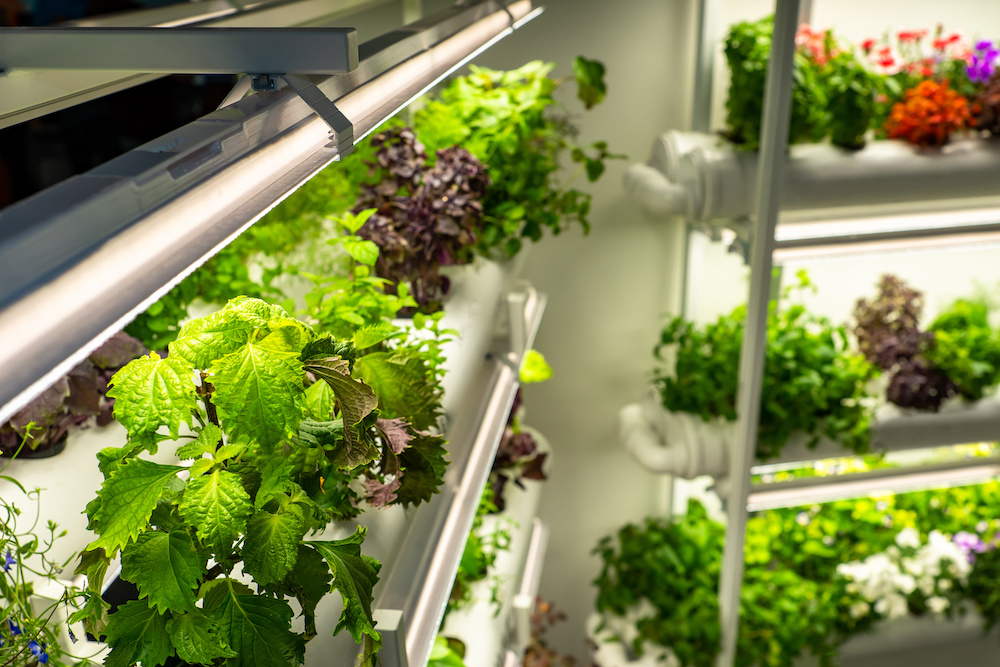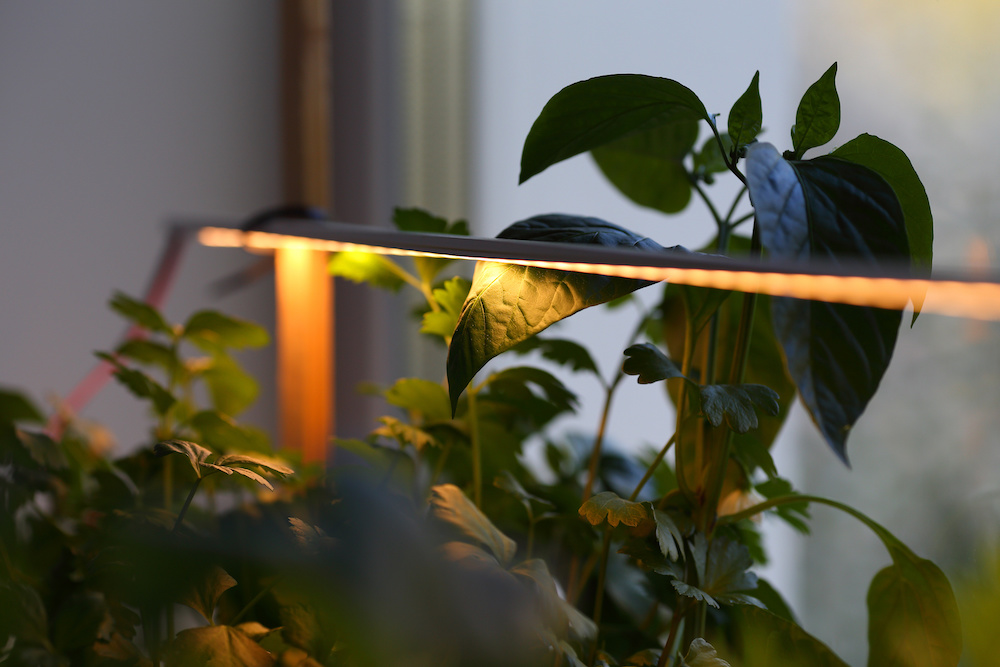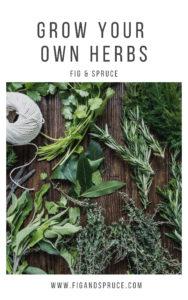Planting and growing vegetables by yourself is not only fun but fulfilling as well.
If you lack the space to grow your greens outdoors, cultivating them indoors is a viable option.
As we discuss growing vegetables indoors with lights, let’s get as much information as we can before we start.
That includes identifying the best vegetables to grow indoors under lights.
Some would say that having an indoor vegetable garden could be taxing, but the rewards you can get make it a worthwhile venture.
Table of Contents
Can I Grow Vegetables Indoors With Grow Lights?
Cold and unforgiving weather is among the main reasons why people strive to grow their veggies indoors.
Fortunately, growing vegetables indoors with artificial lights is a viable option.
On a grander scale, indoor gardening is a vital component that scientists have been preparing.
If we get to the point of successfully sending people to Mars, growing vegetables indoors with lights will be a significant factor in their survival.
You don’t need to be an astronaut to experience growing vegetables indoors.
In fact, lots of gardeners are practicing indoor gardening, especially during the winter season.
While indoor gardening sounds exciting, growing crops under light requires constant attention, proper equipment, and adequate space.
Not all vegetables are fit to grow indoors, but there are lots of popular ones that can grow without sunlight.
What Vegetables Can You Grow Under Grow Lights?
Unless you are a horticulturist or a gardening savant, you may wonder what the best vegetables to grow indoors under lights are.
Below are ten kinds of vegetables you can try to grow in your indoor garden.
Radish
This vegetable can be harvested in under a month.
Radishes have the reputation of being one of the fastest crops to grow. As such, make sure to take advantage of this fact.
You can get a good amount of potassium and other antioxidants with radish.
Radish helps in maintaining your circulatory system healthy as well as other benefits such as providing vitamin C.
It needs 12 to 14 hours of indoor light. You can use regular organic soil or any soil mix with high organic matter.
Onion
One of the most-used vegetables worldwide, including in your indoor vegetable garden, is an onion.
You can grow onions either from seeds, seedlings, or even from scraps.
Similar to radish, onion is known to contain a good amount of antioxidants.
The anti-inflammatory properties of this vegetable help protect you from blood clots and reduce high blood pressure.
Depending on the type of onion, it usually needs about 12 to 16 hours of light.
For the soil, it doesn’t need anything specific. Just make sure the soil is rich in nutrients.
Bell Pepper
Bell peppers are popular for not being picky with their growing environment.
You can use bags, pots, or even plastic bottles as their container.
These vegetables are not very fast growers. However, they become sweeter, and the vitamin C content is more potent the longer it stays on the plant.
As implied above, bell pepper provides high amounts of vitamin C. Other nutrients such as potassium, fiber, vitamin A, and others are also present.
Bell peppers need to be planted on high-nutrient soil. It is recommended to keep them with lights for about 14 to 16 hours per day.
Scallion
Labeled by some as green onions, scallions are used in a plethora of food items.
The scallions are a common ingredient for soups, noodle dishes, dumplings, salads, and many other popular dishes.
Scallions give you adequate amounts of fiber and antioxidants. They also have zero cholesterol and low quantities of calories.
Regular garden soil is enough for scallions to grow. In regards to indoor light, it needs about 16 hours each day.
Mushroom
Unlike other greens, mushrooms thrive in an indoor environment. The easiest types to grow indoors are shiitake, oyster, and white buttons.
Mushrooms are easy to include in anyone’s diet. They are also a popular choice for a meat substitute.
Aside from their good taste, mushrooms have plenty of nutritional value.
They are packed with nutrients like potassium, antioxidants, and zinc, just to name a few.
Mushrooms can grow in any high-nutrient soil. Some recommend having the mushrooms exposed to led lights for only six to eight hours per day.
Potato
Despite not being as nutritious as other vegetables, the potato is easily one of the most famous vegetables in the world.
Various industries have made tons of profit from it, from fast food to paper manufacturing.
The potato contains amounts of potassium, vitamins B and C, and carbohydrates.
However, if we will be blunt, most of us consume potatoes not because of their nutritional content.
Potatoes need soil high in organic matter to grow. It is suggested to let them under grow lights for about eight to 12 hours every day.
Spinach
Spinach is a vegetable used in a lot of recipes of soups, salads, and others. It can be consumed raw or cooked.
This vegetable is regarded by many as a superfood. It has lots of amazing health benefits that can convince anyone to include it in their diet, from hair to bones.
You should use potting mix in growing spinach indoors. When you plant the seeds or seedlings, have them under a grow light for about 14 to 15 hours every day.
Carrot
It is possible to grow carrots indoors with artificial light. Rules for growing indoors and outdoors are essentially the same, and just the right amount of water and light.
Carrots have an abundance of vitamins, fiber, and antioxidants. To get the most nutrients out of carrots, you must eat carrots raw or steamed.
Well-drained mixed soil is suggested in growing carrots indoors. Every day, it needs about 10 to 12 of grow light.
Beet
Regarded by some as a superfood, beets offer a wide range of health benefits, but it also has a reputation of having an unpleasant taste.
Beets are packed with loads of nutrients that you could benefit from, including boosting your energy for workouts and protecting your eyes.
For beets to grow, a moisturized, nutrient-rich soil is required. They require 12 to 14 hours of indoor light, similar to radish.
Kale
Also known as leaf cabbage, kale is regarded as a superfood because of its high nutritional content.
It is a popular ingredient for healthy salads and smoothies.
Kale is at the apex when it comes to health benefits. With its insane amounts of vitamins, notable K and A, and other beneficial compounds, it is labeled by some as the most nutritious of all vegetables.
Potting mix made for growing greens is the best choice to develop your kale.
As for artificial light, it needs about 14 to 16 hours of exposure.
Microgreens
If you are not familiar with microgreens, it is defined as “immature” vegetable plants. As soon as the seedlings grow a bit, it is then harvested.
Lots of garden shops offer a “microgreen mix,” which is a combination of different microgreens.
This mix is popular because it combines the vegetables that complement the flavor of each other and various nutritional benefits.
Some researchers claimed that microgreens are generally more nutritious than fully grown vegetables.
Still, certain conditions should be fulfilled before this claim could be verified.
If you are just starting with indoor gardening, it is highly suggested to start with growing microgreens because it will only take one to two weeks to harvest them.

What Vegetables Can You Grow Indoors Year Round?
Growing vegetables indoors with LED lights enables you to have your favorite greens at a given time.
However, some greens could be challenging to grow during winter or cold weather.
Most of the best vegetables to grow indoors under light listed above are ideal choices.
This time, let’s highlight a few examples of vegetables that you can grow indoors year-round.
Lettuce
For many who have green salad as part of their diet, lettuce is an invaluable ingredient.
Fortunately, lettuce varieties, such as tom thumb and oak leaf, grow indoors regardless of the season.
To get optimal results, a planting mix meant for starting seeds should be strongly considered.
For grow lights, allow your lettuce to be exposed for about 14 to 16 hours daily.
Arugula
Similar to lettuce, arugula is used primarily for green salads.
It is a peppery-tasting vegetable that adds a flair of flavor to a number of dishes.
A potting mix that retains moisture is the recommended base for arugula.
Leave your grow light on for about 10 to 14 hours every day.
Swiss Chard
As a leafy green, the Swiss chard is known for its high nutritional value.
It is filled to the brim with vitamins K and A, making it one of the healthiest greens out there.
Use potting soil mixed with organic fertilizer to plant your chard indoors. It needs only about six hours of exposure under grow light.
Turnip
Similar to radishes and beets, turnips are a root crop available all year round.
The leaves and roots are edible, which makes them a fixture in many recipes.
A well-drained sterilized soil works best with turnips. Set your grow light on for about 12 to 14 hours.
Cucumber
If you have some budget allowance, you can get cucumber seeds made for indoor gardening.
You could also opt for the usual garden variety, but the indoor cucumber seeds get you better results.
It is recommended to plant your cucumber seeds on a potting mix that contains a good amount of organic fertilizer.
Leave your grow light on daily for 12 to 16 hours.
What Grows Indoors With Artificial Light?
So far, we have focused on growing vegetables indoors with LED lights.
For this part, let’s take a look at non-vegetable plants that you could consider growing indoors.
Herbs
Colloquially, we distinguish herbs from vegetables by their taste.
Herbs are used mainly for flavoring and seasoning, while veggies are consumed primarily for their nutritional content.
Here are a couple of herbs you should try growing in your indoor garden.
- Chives
This herb is used as a seasoning for various recipes such as soups, salads, cheese dishes, stews, and many more.
Chives are classified under the onion family and can grow at any time of the year.
Conventional garden soil is enough for chives to grow.
Leave it under a grow light for about seven or eight hours daily.
- Parsley
As one of the most popular natural seasonings, parsley is a typical garnish for many dishes such as soups, salads, and various sauces.
This herb is packed with nutrients such as vitamins and iron.
Use a potting mix meant for vegetables when planting parsley.
Leave this herb under grow light for about 12 to 14 hours each day.
- Rosemary
Primarily used as a food seasoning, rosemary is known for its fragrant scent.
Since ancient times, this plant is also utilized for medicinal purposes such as alleviating body pains.
Rosemary thrives in well-drained soil with a good amount of organic fertilizer.
Leave it under grow light daily for about 10 to 12 hours.
Blooming Plants
All of the plants we have covered so far are used as food or seasoning.
This time, let’s check out a few ornamental plants you can grow under grow lights.
- Orchids
These colorful flowers are being used worldwide as a decorative plant.
Numerous species of orchids are found everywhere except Antarctica.
For orchids, they grow well under a well-moistened potting mix with lots of organic fertilizer.
Some recommend having them bathe in LED lights for about eight to 12 hours daily.
- Lavender
With its aromatic scent and distinct-looking flowers, lavender is a familiar ornament found in many homes.
From the Middle Ages up to today, this plant’s soothing fragrance cannot be understated.
Use high-quality, well-drained potting soil to plant your lavender seeds.
12 to 18 hours under LED grow lights is recommended.
- Poinsettia
As one of the most famous holiday plants, the poinsettia is a red plant often associated with Christmas decors.
While it brings festive cheer to your homes, this shrub may not be safe to be around cats and dogs.
Poinsettias need well-drained, porous potting soil to grow.
Use artificial light with low intensity for about six to eight hours each day.
Best Vegetables To Grow Indoors Under Lights: In Conclusion
There are a lot of vegetables and other plants that you can grow indoors with the help of grow lights.
Just keep in mind that it is also essential to make sure that LED lights maintain a distance from your plants.
Like with natural light, we want to avoid over and underexposure because many of our greens are fragile to cultivate.


